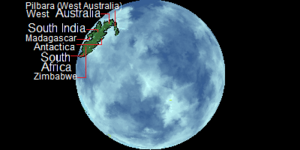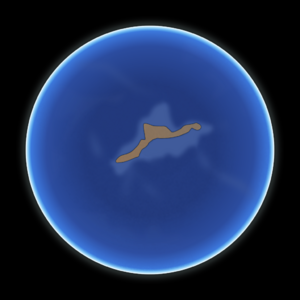Ur (continent) facts for kids
 |
|
| Historical continent | |
|---|---|
| Formed | 3,100 Mya |
| Type | Supercontinent |
| Today part of |
|
Ur is a hypothetical supercontinent that formed in the Archean 3,100 million years ago (3.1 billion).
In a reconstruction by Rodgers, Ur is half a billion years older than Arctica and, in the early period of its existence, it was probably the only continent on Earth, and as such can be considered a supercontinent, though it was probably smaller than present-day Australia. In more recent works geologists often refer to both Ur and other proposed Archaean continental assemblages as supercratons. Ur can, nevertheless, be half a billion years younger than Vaalbara, but the concepts of these two early cratonic assemblages are incompatible.
Incompatible reconstructions
About 1,300–1,071 Mya, Ur joined the continents Nena and Atlantica to form the supercontinent Rodinia. In the reconstruction of , Ur remained the nucleus of East Gondwana until the break-up of Gondwana. In other reconstructions, however, India and East Antarctica did not collide until Rodinia formed 1,071 Mya. Furthermore, in the Early Archaean Earth's mantle was 200 °C hotter than today and many characteristics of modern tectonics, such as ophiolites, blueschists, lawsonite-bearing eclogites, and ultra-high-pressure rocks, did not exist or were rare. This makes most proposed Archaean supercontinents controversial, including Rogers's 3 Gya supercontinent.
Reconstructions of the supercontinent Vaalbara places two cratons, Kaapvaal in southern Africa and Pilbara in western Australia next to each other based on stratigraphic similarities. In Roger's configuration of Ur, these cratons are placed far apart in their Gondwana configuration. This configuration is contradicted by widespread Precambrian collisional events between Australia and Africa.
Yet another possible supercraton, Zimgarn, proposed by and named after the Zimbabwe and Yilgarn cratons, is distinct from both Vaalbara and Ur. Vaalbara and Zimgarn, according to this proposal, both disintegrated about 2.1–2.0 Gya to reassemble as the Kalahari and West Australian cratons 2.524–1.507 Gya. Smirnov et al. based this reconstruction on: (1) Zimgarn was still undergoing cratonisation when an extensive carbonate platform developed over Vaalbara; (2) the magmatic signatures are different for the two supercratons during the period 2.6–2.0 Gya; and (3) paleomagnetic latitudes for 2.69 Gya are slightly different.
See also
 In Spanish: Ur (supercontinente) para niños
In Spanish: Ur (supercontinente) para niños


